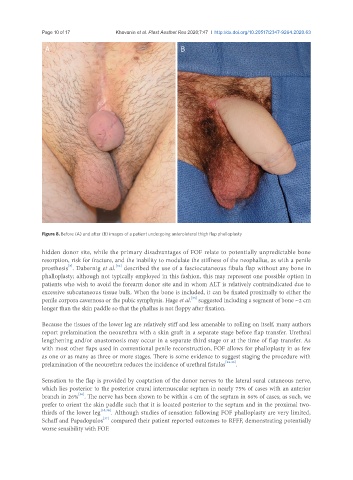Page 539 - Read Online
P. 539
Page 10 of 17 Khavanin et al. Plast Aesthet Res 2020;7:47 I http://dx.doi.org/10.20517/2347-9264.2020.63
A B
Figure 8. Before (A) and after (B) images of a patient undergoing anterolateral thigh flap phalloplasty
hidden donor site, while the primary disadvantages of FOF relate to potentially unpredictable bone
resorption, risk for fracture, and the inability to modulate the stiffness of the neophallus, as with a penile
[3]
[32]
prosthesis . Dabernig et al. described the use of a fasciocutaneous fibula flap without any bone in
phalloplasty; although not typically employed in this fashion, this may represent one possible option in
patients who wish to avoid the forearm donor site and in whom ALT is relatively contraindicated due to
excessive subcutaneous tissue bulk. When the bone is included, it can be fixated proximally to either the
[33]
penile corpora cavernosa or the pubic symphysis. Hage et al. suggested including a segment of bone ~2 cm
longer than the skin paddle so that the phallus is not floppy after fixation.
Because the tissues of the lower leg are relatively stiff and less amenable to rolling on itself, many authors
report prelamination the neourethra with a skin graft in a separate stage before flap transfer. Urethral
lengthening and/or anastomosis may occur in a separate third stage or at the time of flap transfer. As
with most other flaps used in conventional penile reconstruction, FOF allows for phalloplasty in as few
as one or as many as three or more stages. There is some evidence to suggest staging the procedure with
prelamination of the neourethra reduces the incidence of urethral fistulas [33-35] .
Sensation to the flap is provided by coaptation of the donor nerves to the lateral sural cutaneous nerve,
which lies posterior to the posterior crural intermuscular septum in nearly 75% of cases with an anterior
[36]
branch in 26% . The nerve has been shown to be within 4 cm of the septum in 86% of cases; as such, we
prefer to orient the skin paddle such that it is located posterior to the septum and in the proximal two-
thirds of the lower leg [35,36] . Although studies of sensation following FOF phalloplasty are very limited,
[37]
Schaff and Papadopulos compared their patient reported outcomes to RFFF, demonstrating potentially
worse sensibility with FOF.

